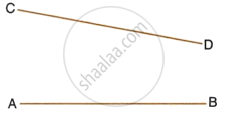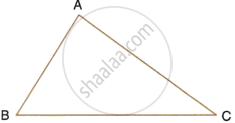Advertisements
Advertisements
प्रश्न
Given: ∠BAC, a line intersects the arms of ∠BAC in P and Q. How will you locate a point on line segment PQ, which is equidistant from AB and AC? Does such a point always exist?
उत्तर
Since, locus of points equidistant from AB and AC is the bisector of ∠BAC. Draw the bisector of ∠BAC intersecting PQ at R.
Since,R is on the bisector, so it is equidistant from AB and AC.
Yes, such a point always exists as there will be definitely a point where angular bisector and line will intersect.
Hence, R is the required point.
APPEARS IN
संबंधित प्रश्न
Construct a right angled triangle PQR, in which ∠Q = 90°, hypotenuse PR = 8 cm and QR = 4.5 cm. Draw bisector of angle PQR and let it meets PR at point T. Prove that T is equidistant from PQ and QR.
In the figure given below, find a point P on CD equidistant from points A and B.

In the given triangle ABC, find a point P equidistant from AB and AC; and also equidistant from B and C.

Describe the locus for questions 1 to 13 given below:
1. The locus of a point at a distant 3 cm from a fixed point.
Describe the locus of the centre of a wheel of a bicycle going straight along a level road.
Describe the locus of the moving end of the minute hand of a clock.
Describe the locus of points at distances less than 3 cm from a given point.
Describe the locus of points at distances less than or equal to 2.5 cm from a given point.
ΔPBC, ΔQBC and ΔRBC are three isosceles triangles on the same base BC. Show that P, Q and R are collinear.
Use ruler and compasses for the following question taking a scale of 10 m = 1 cm. A park in a city is bounded by straight fences AB, BC, CD and DA. Given that AB = 50 m, BC = 63 m, ∠ABC = 75°. D is a point equidistant from the fences AB and BC. If ∠BAD = 90°, construct the outline of the park ABCD. Also locate a point P on the line BD for the flag post which is equidistant from the corners of the park A and B.
